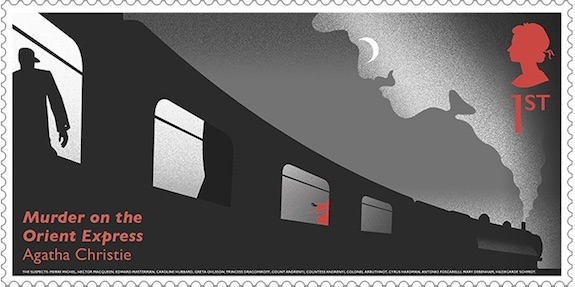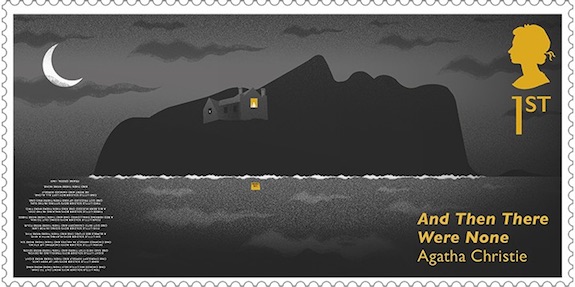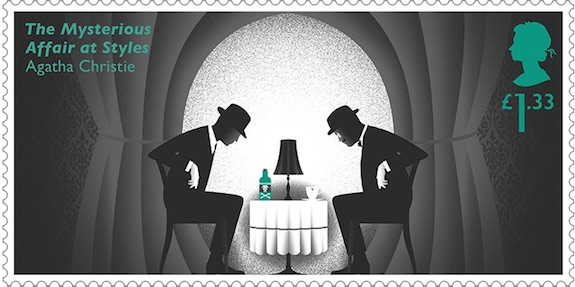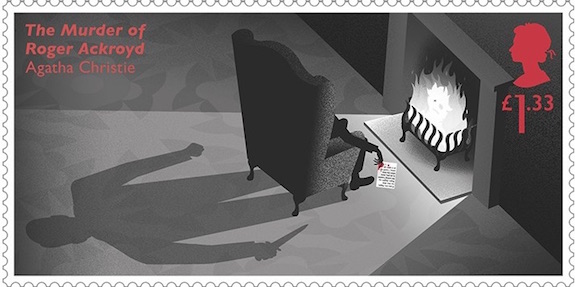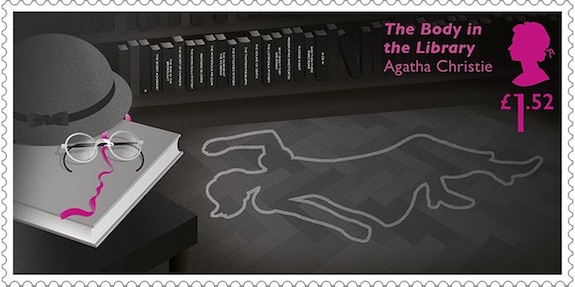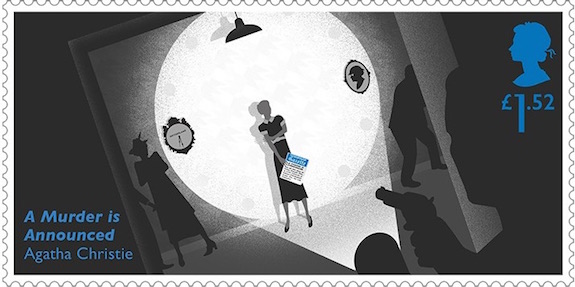Norvic Philatelics - GB New Stamps and Special Postmarks
Agatha Christie - 15 September 2016
This
set of stamps commemorates the mysteries of the bigge st-selling
novelist of all time marking the centenary of Agatha Christie
writing her first story, the ‘birth’ of Hercule Poirot, as well as
the 40th anniversary of Christie’s death.
The six Special Stamps mark the timeless characters and absorbing
mysteries of ‘The Queen of Crime’. “ It is the brain, the little
grey cells on which one must rely. One must seek the truth within
– not without.” Hercule Poirot Agatha Christie, the ‘Queen of
Crime’, is the world's best-selling writer, outsold only by
Shakespeare (and the Bible). The Agatha Christie catalogue
consists of 66 crime novels, 6 romance novels, 150 short stories
and 19 plays. Her works have been widely adapted and produced
across most media platforms around the world, including TV, film,
radio, publishing, stage and very successful digital games. |
|
1st class - Murder on the Orient
Express; And Then There Were None;
£1.33 - The Mysterious Affair ay Styles; The Murder of Roger
Ackroyd;
£1.52 - The Body in the Library; A Murder is Announced.
Although shown alongside each other, the stamps in each value
are in vertical se-tenant pairs in the sheet.
|
Background
She has sold over 2 billion copies of her books worldwide – 1 billion in the
English language and 1 billion in over 100 different languages. Her books
and fictional creations continue to live, with book sales averaging 3 -4
million books a year worldwide and around 30 feature films and 200 TV
productions having been screened based on her novels. While her
books are quintessentially English in their settings as are most of her
characters, the subject matter is surprisingly less cosy: murder, adultery,
forgery and blackmail fill the pages. Since her debut in 1920, Agatha
Christie’s books have never been out of print. She was the first crime
writer to have 100,000 copies of ten of her titles published by Penguin on
the same day in 1948 - A Penguin Million.
Hercule Poirot featured in 53 novels, one play and more than 50 short
stories, making him one of the most famous fictional characters of all time.
The Belgian detective was due to retire from the Belgium Police when war
started. He apparently had an international reputation for crime solving and
when he was injured (possibly on active service) he moved to England as a
refugee. We first meet him living in Essex, and he appears to be in late
middle -age (maybe late 50s). A native French speaker, he is also fluent in
German, Italian and (haltingly) in English. He is fond of his moustache
(‘very stiff and military’), and in the early novels consults his large
pocket watch. Hastings described him as a ‘quaint, dandified little man’
with a height of ‘hardly five feet, four inches’. His eyes are g reen, his
eyebrows expressive when in deep thought. His detective method is to use
pure reason and his knowledge of human psychology. His triumph over ‘The
Mysterious Affair at Styles’ leads him to develop his career as a private
detective.
When Christie finally killed off Poirot the character received an obituary
in the New York Times, the only fictional character to have been so
honoured.
The stamps in detail
1st Class: Murder on the Orient Express,
1934
Returning from Syria, Poirot travels on the Orient Express bound for Calais
in the company of shady fellowpassengers. Mr Ratchett approaches Poirot
saying he had been threatened and offers a large fee for him to take the
case. Poirot declines saying, ‘I do not like your face’. That night Ratchett
is murdered. The train is caught in a snowdrift and Poirot is persuaded to
take on the case. The novel was shortlisted by the Crime Writers Association
poll for the greatest crime novel of all time.
1st Class: And Then There Were None, 1940
Christie wrote several novels and many short stories and plays (under her
own name) that do not feature her most famous creations, including And Then
There Were None in which eight people are invited to an island, attended by
a butler and his wife. An old fashioned gramophone plays a recording
accusing each of murder, and then each is murdered in a way outlined in the
rhyme Ten Little Soldier Boys. Eventually all die – the police are baffled,
but a chance discovery explains all.
£1.33: The Mysterious Affair at Styles,
written 1916, published 1920 (US)/1921 (UK)
In the first introduction to Poirot, the story is told by Captain Arthur
Hastings, on sick leave in Essex after being invalided while serving in the
First World War. He encounters Poirot in the village, having already made
his acquaintance from working on a police case with him before the War. That
same night a Mrs Inglethorp (of the house where Hastings is staying) dies of
Strychnine poisoning. Her husband is arrested and Poirot is enlisted to
investigate. Afterwards Hastings becomes a kind of Watson to Poirot’s Holmes
in numerous stories.
£1.33: The Murder of Roger Ackroyd, 1926
The classic whodunit is narrated by Dr Sheppard, friend of Roger Ackroyd.
Ackroyd is found murdered with an ornate knife in his neck, in a room locked
from the inside, with many suspects who have motives for murder. Sheppard’s
next door neighbour is none other than Poirot who rules out suspects one by
one. He is assisted by Sheppard’s sister, Caroline (thought to be the
prototype for Miss Marple). The twist in the final chapter has divided
critics and readers ever since it was published and is a cornerstone in the
modern crime novel and a prime example of the ‘locked room’ style of
mystery. The book was voted the ‘Greatest Crime Novel of All Time’ by the
600 members of the Crime Writers Association.
£1.52: The Body in the Library, 1942
(biggest selling Marple book)
Mrs Dolly Bantry awakes to find a dead woman in the library. She calls her
good friend Miss Marple to investigate and the aged sleuth pits her wits
against Inspector Slack. After a second murder Marple sets a trap for the
killer. Since its first publication in 1942 it has gone on to become the
biggest selling Marple book
£1.52: A Murder is Announced, 1950 (in top
list of Christie novels)
In the personal columns of the local paper, an ad announcing a murder and a
time and place is published. Assuming it is a party of some sort, half the
village turns up. The lights go out and shots ring out. Leticia Blacklock
(owner of the location of the shooting) lies injured next to a dead man.
Chief Inspector Rydesdale thinks it is an accident or suicide, but
encounters Miss Marple at lunch at the local hotel who examines the evidence
and draws her own conclusions. She goes to the village to investigate the
murders that ensue.
Acknowledgements:
Murder on the Orient Express © 1934 Agatha Christie Limited. All rights
reserved; And Then There Were None © 1939 Agatha Christie Limited. All
rights reserved; The Mysterious Affair at Styles © 1920 Agatha Christie
Limited. All rights reserved; The Murder of Roger Ackroyd © 1926 Agatha
Christie Limited. All rights reserved; The Body in the Library © 1942 Agatha
Christie Limited. All rights reserved; A Murder Is Announced © 1950 Agatha
Christie Limited. All rights reserved; AGATHA CHRISTIE, POIROT, MURDER ON
THE ORIENT EXPRESS, MISS MARPLE and the Agatha Christie Signature are
registered trade marks of Agatha Christie Limited in the UK and/or
elsewhere. All rights reserved.
Technical details:
The 60 x 30 mm vertically se-tenant pairs of stamps were designed by
Studio Sutherland, printed in sheets of 24/48 by International
Security Printers in Lithography. No details of the perforation or
phosphor arrangements have been provided.
The stamps
also feature 'visual' clues some of which are more obvious than others
(the skull on 'Styles', and the apparent dagger on 'Roger
Ackroyd'. Others are in microtext, or in thermochromic ink, or
only visible under an ultra-violet light. No details of
these can be published at this stage.
Products issued - these can be obtained from Royal Mail. (This
page is for information only, we will not be stocking these stamps.)
Set of 6 stamps - Presentation Pack - Set of 6 stamp cards - First Day
Cover - Unaddressed Souvenir Cover
Special first day of issue postmarks
Postmarks available for the day of issue
will be shown in Royal Mail's Postmark Bulletins (download
here).
If you would like to be
notified when this page changes use the 'ChangeDetection' box above.
This page created 16 August 2016.
